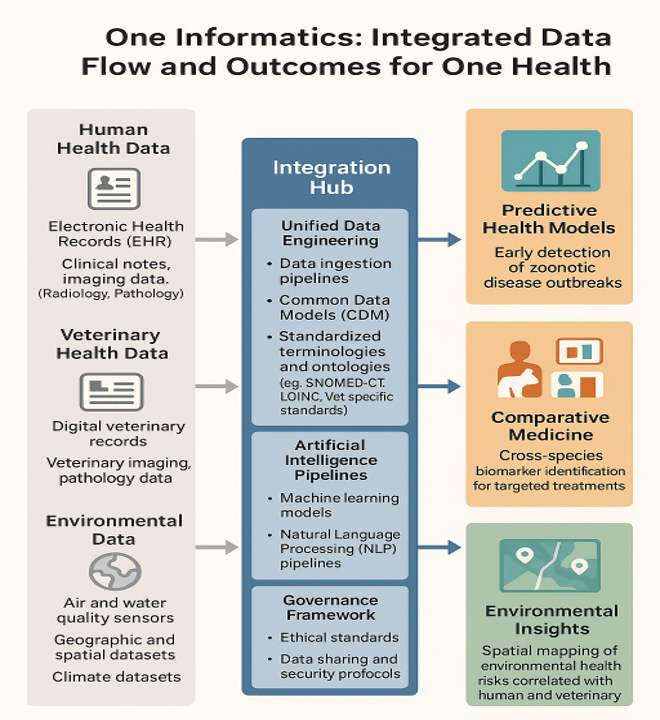Brundage Lab Launches at UW–Madison School of Veterinary Medicine
Dr. David Brundage University of Wisconsin–Madison

Resources
We are excited to share that the Brundage Lab will be launching at the University of Wisconsin–Madison School of Veterinary Medicine this fall! As part of the Department of Surgery, our lab is an interdisciplinary team with specific interests in developing agentic, generative, and multimodal artificial intelligence tools to support the diagnosis and prognosis of disease systems in both veterinary and human medicine. Our goal is to leverage a foundation of biomedical informatics and our experience in broad health information systems and electronic health data to better understand how to combine and integrate veterinary and human EHR and information systems to support One Health.
We believe that any successful implementation of a clinical AI system, no matter the patient’s species, requires careful collaboration and side-by-side development with clinicians. We also believe in the principle of “Augmented Intelligence Systems,” where any deployed AI should never be autonomous in clinical decision-making without a clinician in the loop. Even before the current trend of agentic systems built on large language models, we already had the concept of clinical decision support systems to aid clinicians in treatment and diagnostic decisions. While these were often built on sophisticated heuristic rule engines, a licensed clinician has always remained responsible for ultimate decision-making. This is now shifting to more advanced AI systems.
So, how do clinicians interact with emerging artificial intelligence systems? What does “Agentic AI” mean in medicine when the AI cannot be held liable? How are clinicians trained to use these tools as part of their education as well as their practice? How do we utilize emerging technology to train the next generation of clinicians? The Brundage Lab looks to explore the interaction of these intelligent systems with clinicians in order to understand the limitations of the augmented clinician. We also believe that clinical AI is not limited to physicians and veterinarians but should also be used to elevate ancillary care staff working in resource-limited settings.
The Brundage Lab believes in researching all aspects of AI in practice. Advancing AI isn’t just about better algorithms—it also requires an ecosystem built on data, standards, and continuous evaluation. Beyond model development, we must also explore how to access and deliver high-quality multimodal data, and how that data is curated and annotated with domain expertise. Can we identify new, scalable labeling strategies? How do we ensure that patient data is de-identified, private, and secure? How do we enrich and refine models through post-processing? Do we need new, robust, representative, and reproducible evaluation metrics? What about new benchmarks specifically for veterinary medicine and One Health? Finally, how do we integrate and deploy AI in real-world applications?
The Brundage Lab explores research across this complete AI lifecycle. To move the field forward, we must invest as much in the pipeline as in the model. Translational AI must require achieving a production deployment and monitoring as a final outcome. Informatics allows us to continue exploring how we integrate human and veterinary medicine to achieve One Health by identifying gaps in current terminologies, ontologies, data-sharing frameworks, and interoperability standards across species and healthcare systems. Addressing these gaps will enable more unified datasets, facilitate cross-species comparative studies, and create opportunities for collaborative research that directly benefits both human and animal health. The Brundage Lab is also specifically interested in mobile and edge-deployed models in resource-limited environments. How can we bring AI out into the field or to low- and middle-income countries to support care delivery?
The Brundage Lab believes that the next generation of care delivery will be through personalized, precision medicine. This is also true for veterinary medicine. The development and integration of multi-omic (genomics, transcriptomics, proteomics, etc.) algorithms and data will continue to lead to new insights and treatment opportunities. The lab aims to develop new algorithms and methods to identify and integrate morphometrics from the microscopic (pathomics) to the macroscopic (radiomics) in veterinary medicine.
As we launch this new chapter at UW–Madison, the Brundage Lab is committed to building an open, collaborative, and forward-looking research program that bridges the boundaries between veterinary, human, and planetary health. By combining rigorous informatics, cutting-edge AI, and a One Health perspective, we aim not only to advance scientific discovery but also to create practical tools that improve clinical outcomes and expand access to care across diverse contexts. We look forward to working with students, clinicians, and collaborators worldwide to shape the future of intelligent health systems.






